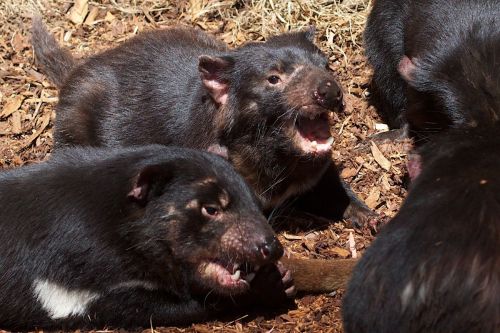The spotted hyena is one of Africa’s most recognizable animals, also known as the laughing hyena. It is the largest living member of the hyena family, physically distinct from other species.
The spotted hyena is an animal with fascinating behaviors and unique abilities, whose presence in African ecosystems is vital to the balance of nature. As a mysterious animal, a mix of intelligence, strength, and hunting ability, it is shrouded in a bad name that evokes negative associations among people. Nevertheless, it remains an enigmatic symbol of African savannas, deserts, and forests.
It belongs to the hyena family (Hyaenidae) and the hyena subfamily (Hyaeninae) and is the largest of the modern hyenas.
The hyena family includes two contemporaneous subfamilies:
It was once thought that the mottled hyena’s name Crocuta came from the Latin word “crocutus,” which means “saffron-colored” (in reference to the color of the animal’s fur). In fact, the name Crocuta comes from the ancient Greek word Κροκόττας “crocotta,” which was originally thought to mean golden jackal.
The earliest mention of Κροκόττας comes from Strabo’s Geographica (Strabon’s 17 books on geography), where the animal is described as a wolf-dog mic native to Ethiopia.
Their range extends from the Sahel (a geographic area stretching along the southern fringes of the Sahara) to South Africa (except in lowland tropical rainforests). In West Africa, the distribution of the spotted hyena is patchy, with the species rarely found outside protected areas.
The largest populations live in the Serengeti and Kruger National Park in East Africa. They are extinct in some areas, such as Algeria and central Africa, but are making a comeback in some regions. In Ivindo National Park in Gabon, the first animal in about 50 years was observed in the early 2000s.
They can be found in savannas, semi-deserts, open woodlands, and mountain forests. In the highlands of Ethiopia, spotted hyenas live at elevations of up to 4100 meters. The animals avoid open deserts and low-lying rainforests, such as the Congo Basin.
They are not afraid of humans and can be found near villages or other human settlements.
The body length of adults is 125-160 centimeters, and the tail length is 22-27 centimeters. Height at the withers is 77.3-80.7 centimeters. Body weight is 45-55 kilograms, sometimes it can reach up to 85 kilograms. Female spotted hyenas are larger than males by about 10 percent. Sexual dimorphism is not strongly apparent here (females are 2.3 percent longer than males, with slightly larger skull and chest circumferences) and varies regionally, being more pronounced in South Africa.
The front limbs are longer and stronger than the hind limbs, causing the back to lean back. The rump is rather rounded, making it impossible for an attacker from behind to get a firm grip. Each foot has four toes, which are provided with blunt, immobile claws. Spotted hyenas, like all hyenas, are fingered.
The spotted hyena’s tail ends in a black, bushy tip, with hair extending about 12 centimeters beyond the end of the tail.
This hyena has one of the strongest skulls among predators. The jaws are strong and, due to their construction, they can develop a bite force of more than 9000 newtons (40 percent more than a leopard can generate). The jaws of the spotted hyena surpass those of the brown bear in their ability to crush bone.
It is relatively short and coarse, and the long dorsal mane is less pronounced in the spotted hyena than in other hyenas. The basic fur color is sandy yellow to reddish brown. There are numerous black and dark brown patches on the back, flanks, and legs.
One of the most unusual features of the spotted hyena is the masculinization of females. The female’s genitalia closely resembles those of a male. Females do not have a vaginal vestibule or vulva. The clitoris is shaped and positioned like a penis (pseudo-penis) and is capable of erection.
A urogenital canal passes through the pseudo-penis, through which the female urinates, copulates, and gives birth.
There are usually 15 to 80 individuals in a clan. Clans of spotted hyenas are more tightly knit and united than wolf packs, but not as tightly knotted as clans of African wild dogs.
All clan members know each other, live in a common territory, and raise their young in a common cave, but spend a lot of time alone or in small groups (a society based on fission and fusion).
The territory occupied by a clan usually covers about 50 square kilometers. The clan is usually led by a female.
Representatives of both sexes can copulate with several partners over the course of several years. Copulation lasts 4-12 minutes and usually takes place at night when no other hyenas are present.
Individuals of both sexes have an erection when they mate and greet each other vigorously.
A 2012 study shows that spotted hyenas can solve puzzles. To achieve a goal, they experiment in many ways, which shows their creative thinking. They can assess the number of intruders in their territory and only launch an attack when they have the majority.
Spotted hyenas plan to hunt specific species; they scent-mark before setting out to hunt zebras, which is not the case when hunting other animal species.
They have a heightened sense of smell and unique scent signatures, which allows them to distinguish themselves from other clans. They also exhibit deceptive behaviors that involve sounding alarms while feeding, when no enemies are present. This helps scare off other hyenas to eat in peace.
It is the most carnivorous representative of hyenas, unlike other hyenas. Spotted hyenas hunt, mainly wildebeest, zebras, and gazelles. They do not have a preference for any one species; rather, they are guided by the weight of the animal. Smaller prey is killed by shaking it in their mouths, while large ones are torn apart and eaten while still alive.
Their food is 60-95 percent animals they hunt themselves, but they also eat carrion and engage in kleptoparasitism, meaning they steal prey from other predators. They locate their prey by sight, hearing, or smell. They can sniff out carrion from 10 kilometers away.
Thanks to their powerful teeth, they can break even thick bones. A group of 20-30 spotted hyenas can completely consume a wildebeest, except for small remains, in 13 minutes. These animals eat an average of 1.5 to 3.8 kilograms of meat per day. However, having a large supply of food, they can devour 18 kilograms of meat in an hour.
Kleptoparasitism is also practiced by other animals, such as jackals, cheetahs, leopards, African wild dogs, and other hyenas. However, the most common food competitors for spotted hyenas are lions, and food theft happens both ways.
The most common sound is a loud “shout” heard over a radius of several kilometers. This sound is used to summon clan members to defend territory, and indicate food supplies or danger. Other sounds include the “grunt,” the high-pitched cry-like sounds of young individuals that signal hunger, and cow-like sounds that put group members in a state of excitement.
There is also a sound resembling human laughter. Their rich repertoire of laughter is a sophisticated way of communicating. With a “giggle,” spotted hyenas communicate their species’ age, rank in the herd, and intentions. They emit a poignant giggle when they are preparing to attack.
Like most predators, they stay away from humans, maintaining a distance of about 300 meters. However, this distance decreases at night when these animals come out to feed. Large specimens of hyenas choose to attack humans. A pair of cannibal hyenas responsible for killing 27 people in Malawi in 1962 weighed 72 and 77 kilograms when shot. Victims are usually women, children, and sick, infirm people.
Although attacks on living humans are rare, the spotted hyena readily prey on human corpses. In Masai and Hadza traditions, corpses are left out in the open for spotted hyenas to devour. If they are not devoured, they are seen as those who can cause social disgrace. Therefore, the corpse is often covered with the fat and blood of the slaughtered ox.












